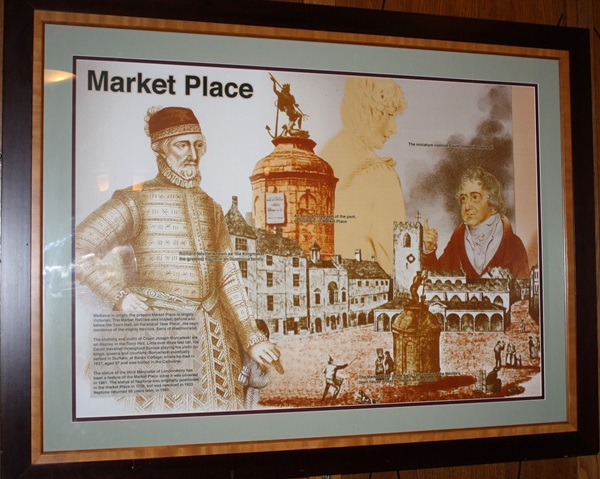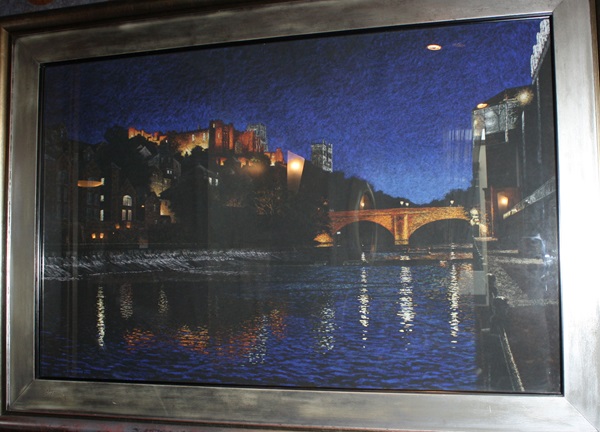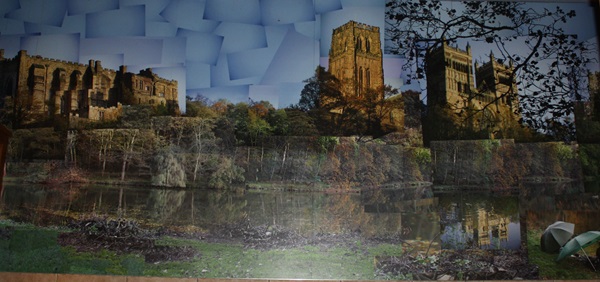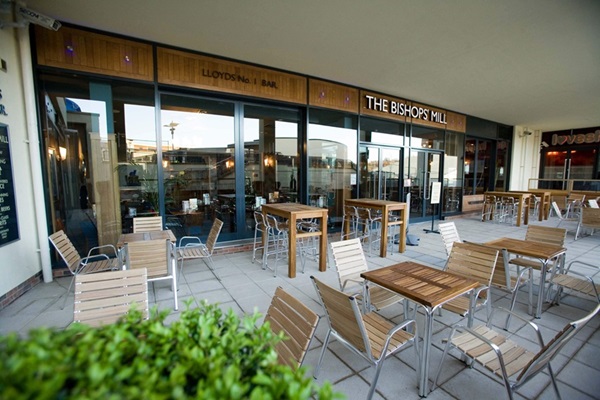This pub is named after the historic mill which stood for centuries adjacent to this site. First recorded in the Boldon Book of 1183, the bishop’s mill was the place where the freemen of Durham could grind their corn. The corn mill was rebuilt in the 17th century and stood here until 1972. The mill race was later used to power the adjacent ice rink.
Prints, illustrations and text about The Bishop’s Mill.

The text reads: The Wetherspoon freehouse, on Walkergate, is named after the historic mill that stood adjacent to this site for centuries. First recorded in the Boldon Book, of 1183, the Bishops Mill was the place where the freemen of Durham could grind their corn.
They are recalled by Freeman’s Place, which led to the Freeman’s Common pasture. Walkergate recalls the ‘walkers’, or cloth workers, who once worked here.
In the 18th century woollen manufacture was revived in the city by John Starforth, whose carpet factory became the city’s main employer. It was later taken over by Gilbert Henderson, who moved the business to Walkergate in the 1840s.
The Henderson Carpet Factory remained on this site until 1903, when it was sold to Crossleys. The new owners made the most of workforce redundant but some of the buildings and machinery were leased by Hugh Mackay. Mackays manufactured high quality carpets at Walkergate until 1970.
Prints and text about the Bishop of Lindisfarne.

The text reads: Born in Melrose (now in the Scottish borders), Cuthbert became Bishop of Lindisfarne and one of the most venerated of English saints.
Posthumously he was hailed as a miracle worker. It was Cuthbert who converted Lindisfarne to Roman Christianity from Celtic Christianity, following the synod of Whitby in 664. He was also one of the world’s earliest wildlife conservationists and the Eider Duck is known locally as the Cuddy Duck in his memory.
After his death, the Lindisfarne Gospels were written in his honour. In 875 his body was removed from Lindisfarne following Viking raids and after many travels was laid to rest in a loop of the River Wear. According to tradition the monks carrying St Cuthberts coffin were inexplicably halted in their tracks and the saint appeared to them telling the monks to take the coffin to ‘Dun Holm’ (meaning Hill Island), which later became Durham. The magnificent Durham Cathedral was built on the site and his tomb may still be seen there.
Prints, illustrations and text about Market Place.

The text reads: Medieval in origin, the present Market Place is largely Victorian. The Market Hall lies well hidden, behind and below the Town Hall, on the site of ‘New Place’, the town residence of the mighty Nevilles, Earls of Westmoreland.
The clothing and violin of Count Joseph Boruwlaski are on display in the Town Hall. Little over three feet tall, the Count travelled throughout Europe playing his violin for kings, queens and courtiers. Boruwlaski eventually settled in Durham, at Banks Cottage, where he died in 1837, aged 97 and was buried in the Cathedral.
The statue of the third Marquess of Londonderry has been a feature of the Market Place since it was unveiled in 1861. The statue of Neptune was originally positioned in the Market Place in 1729, but was removed in 1923. Neptune returned 68 years later, in 1991.
Prints and text about notable families from Durham.

The text reads: The Neville family, from inconspicuous beginnings after the Norma Conquest, became by the fourteenth century one of the most influential groups in the north of England, virtually ruling the area by means of the royal offices they held, and their political power reached its zenith in the fifteenth century with Richard de Neville, Earl of Warwick, the –co-called Kingmaker.
The Lumleys of Lumley Castle have ranked among the greater nobility since Saxon times. They have been closely allied in marriage to the Lambton, who were Durham landowners from the 12th Century. When the County of Durham sent its first MP to the House of Commons in 1675, William Lambton was elected. In 1761 General John Lambton won the seat made vacant by his brother’s death, and retained it until retirement in 1787. His grandson was the famous reformist politician John Lambton, first Earl of Durham, known as ‘Radical Jack’ for his popular sympathies.
The Surtees were another great family in these parts, their surname referring to the River Tees. Robert Smith Surtees was born in 1805 into this typical nineteenth century Durham squire’s family, dominated by country sports, and went on to fame as the creator of the sporting comic characters Jorrocks and Mr Soapy Sponge.
The Bowes family were once widespread in Durham. Sir George Bowes is particularly remembered for his defense of Barnard Castle against an uprising in the north that threatened the overthrow of Queen Elizabeth 1st.
Prints and text about Bishop Tunstall, Bishop Morton and Bishop Crewe.

The text reads: “There are two kings in England, namely the Lord King of England, wearing a crown in sign of his regality and the Lord Bishop of Durham wearing a mitre in place of a crown”.
County Durham is unique. For many centuries it was a virtually independent state ruled not by the king, but by powerful ‘Prince Bishops’.
To secure the north of his new kingdom, William the Conqueror relied on Northumbria’s two most powerful men, its Earl, seated at Bamburgh, and the Bishops of Durham, who were the successors to the earlier Bishops of Lindisfarne. In time the Earl’s powers were conferred upon the Bishops. The Conqueror’s son, King William Rufus continued his father’s policy, and the Durham bishops remained the religious leaders for the whole of Northumbria until the creation of the diocese of Newcastle upon Tyne in the nineteenth century.
Top: left, Bishop Tunstall, right, Bishop Morton
Right: Bishop Crewe.
A pastel painting entitled The River Room Pastels by Gillie Cawthorne.

Gillie lives and works in Durham. She works mainly in water colours and pastels, seeking to convey her fascination with the effects of light and atmosphere.
She is particularly drawn to the tremendous scenic effects to be found in Durham, with the interplay between the river, the tree-clad slopes that rise above it, its bridges, and the soaring skyline of Castle and Cathedral.
A wall mural displaying scenes from Durham.

External photograph of the building – main entrance.

If you have information on the history of this pub, then we’d like you to share it with us. Please e-mail all information to: pubhistories@jdwetherspoon.co.uk